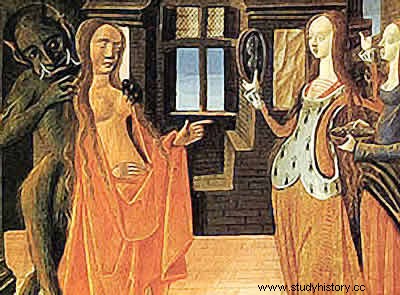
By Rainer Sousa
Sin or necessity? This was the great dilemma faced by medieval clerics as they set themselves to the difficult task of converting barbarian and Roman Europe to Christianity. From a formal point of view, prostitutes violated one of the most important taboos of the Church by practicing fornication. On the other hand, the demands of the everyday world reiterated, time after time, that banning prostitution was a virtually impossible mission.
One of the most common justifications for maintaining active prostitution revolved around the control of sins seen as more serious. Young men's use of brothels served as a means of preventing respectable women from falling victim to cunning seduction and rape. In the end, it would be less serious to violate the limits of the body of a woman who had already fallen into sin than to disgrace a chaste follower of the Church's moral principles.
St. Augustine himself warned that the ban on prostitution would be a gateway to other even more controversial sins. However, some clerics spared no effort for prostitutes to abandon their life of errors through marriage or entering their own religious ordination, as nuns. In the early Middle Ages, some Romans reacted to the religious conversion of prostitutes by forcing Christian women to take the convert's place.
When talking about the development of such activity, we cannot forget that the recurrence of such practice is directly linked to the urban environments of the time. Not infrequently, it was customary to determine the place of houses of prostitution in the streets that had the word “rose” in the name. In some regions, the expression “pluck a rose” alluded to the act of using prostitution. Another common code of distinction was the use of specific clothing and accessories such as hats, bells and shawls.
One of the rare known exceptions to this relationship between prostitution and cities appears in the Kingdom of the Franks, more specifically in the Carolingian dynasty, between the 8th and 9th centuries. In some manors, the so-called “women's houses” were built, where the servants provided themselves with a service far removed from the agriculture developed in the meek. Similar to the present day, these “feudal prostitutes” had a short career and were considered old when they reached the age of thirty.
At the same time, we observe that the medievals used the most varied explanations to justify the phenomenon of prostitution. Some linked it to the natural tendency that some have to moral degradation, others linked it to the issue of recurrent misery in some places or to the economic viability of the act itself. In some cases, concubinage imposed rights and duties between a prostitute and a third party interested in her services.
In the end, we see that medieval prostitution reveals a sphere that extrapolated the moral condition of that time. Observing the criteria, measures and notions about the “oldest of professions”, we see that the Middle Ages were not unconditionally bound by the supposed rules of behavior of the Church. It is, at the very least, instigating to observe the clash between earthly experience and divine aspirations that took place in this terrain of medieval everyday life.
Middle Ages
